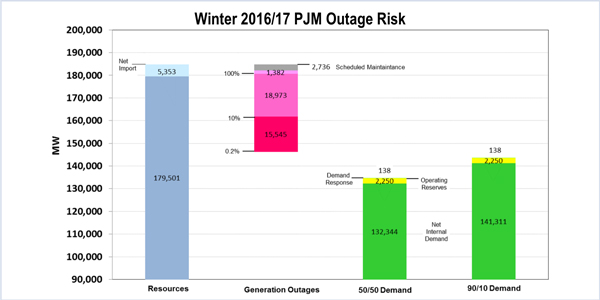Counterflow
By Steve Huntoon
My last couple columns have explored the Department of Energy’s “Cash for Clunkers” proposal. The first column discussed how it will cost tens of billions of dollars and subsidize less reliable generating resources to suppress more reliable resources.[1] The second column showed that the proposal is the direct result of meetings between President Trump and Robert Murray, coal mine owner and major fundraiser for the president’s campaign,[2] not some deliberative process involving well-informed, well-intentioned people.
Robert Murray’s Confirmation
A shout-out to Murray for providing a smoking gun one day after my last column ran, confirming that the DOE proposal is all about selling more of his coal to FirstEnergy power plants, one way or another.[3]
1 in 5,000, and Then Some
Some folks may still think that the situation can’t possibly be that outrageous. The DOE proposal can’t be that devoid of merit.
Wrong.
The smoking gun below is from ReliabilityFirst, the regional reliability organization responsible for reliability in the Mid-Atlantic and Midwest states (the states that are the focus of the DOE proposal).[4]
Please bear with me in explaining this graphic. It’s displaying the winter. The leftmost column is showing generating resources. The next column is showing possible reduction in those resources due to resource outages, based on the last five winters (including the polar vortex). The percentages on the left are the chance of cumulative outages exceeding the associated outage quantity.[5]
The biggest cumulative reduction in resources has a 0.2% chance of occurring. That is one in 500.
OK, now skip the 50/50 Demand column and look at the 90/10 Demand column. That reflects a one-in-10 chance of the coldest weather.
Please note that resources at a one-in-500 worst case (the second column) are still much more than the peak demand in the one-in-10 worst case (the last column).
In other words, combined there is much less than a one-in-5,000 (500 x 10) chance of peak demand exceeding resources in the winter.
And there’s more!
What if that less-than-one-in-5,000 situation were to occur? Fuel supply interruption is unlikely to be a major factor.[6] And RTOs like PJM have tools to avoid customer impact, such as public appeals for conservation and voltage reductions.[7] And any resource-demand shortage would last only hours, not weeks or of course months.[8]
The DOE proposal is much ado about nothing.
The Worm Will Turn
Here’s the third smoking gun. If FERC goes forward with subsidizing certain resources for an insignificant quality like fuel supply on site, it should recognize really important qualities like environmental/public health damage.[9] In the case of coal, the National Research Council of the National Academies estimates that coal generation causes pollution damage averaging $32/MWh.[10]
This means coal resources should pay $32/MWh for their generation, to be subtracted from whatever revenues they otherwise would receive. The payments should be distributed to those hurt by coal generation.
This administration won’t do that, but no administration is forever. Once the precedent is set for FERC to put its thumbs on the scales, coal better hope that the worm never turns.
- https://rtoinsider.com/ferc-baseload-power-energy-department-doe-76332/ ↑
- https://rtoinsider.com/murray-energy-department-of-energy-76903/ ↑
- Murray said he had pressed Trump and Energy Secretary Rick Perry to have the secretary order financial support for at-risk coal plants using DOE emergency authority, but department and White House lawyers ruled that out. “They didn’t want to declare the emergency,” he said. “It was a low point because we worked hard at it and knew it was needed.“They’re doing it in a different way,” Murray said. “Now we have another approach that’s in use to get to the same point.” https://www.eenews.net/energywire/2017/10/11/stories/1060063287 ↑
- https://www.rfirst.org/reliability/Documents/2016-17%20RF%20Assessment-Winter%20Resource.pdf ↑
- ReliabilityFirst says, “To the left side of the range of random outages are probability percentages related to the amount of random outages that equal or exceed the amount of outages shown above that line on the outage bar.” ↑
- “Between 2012 and 2016, there were roughly 3.4 billion customer-hours impacted by major electricity disruptions. Of that, 2,382 hours, or 0.00007% of the total, was due to fuel supply problems.” http://rhg.com/notes/the-real-electricity-reliability-crisis. ↑
- Described in excruciating detail in PJM’s Manual 13, http://pjm.com/-/media/documents/manuals/m13.ashx. ↑
- In the polar vortex, the generation emergencies in PJM aggregated 20 hours. http://pjm.com/-/media/committees-groups/committees/elc/postings/performance-assessment-hours-2011-2014-xls.ashx?la=en. ↑
- An elaborate and persuasive discussion of this proposition is provided by Professors Meredith Fowlie and Maximilian Auffhammer: https://theconversation.com/why-rick-perrys-proposed-subsidies-for-coal-fail-economics-101-83339. ↑
- https://www.nap.edu/catalog/12794/hidden-costs-of-energy-unpriced-consequences-of-energy-production-and (page 92, converting from kilowatt-hours to megawatt-hours). Damage from natural gas pollution is $1.60/MWh (page 118). Damage from nuclear pollution is small (page 150). These figures do not include greenhouse gases. ↑




